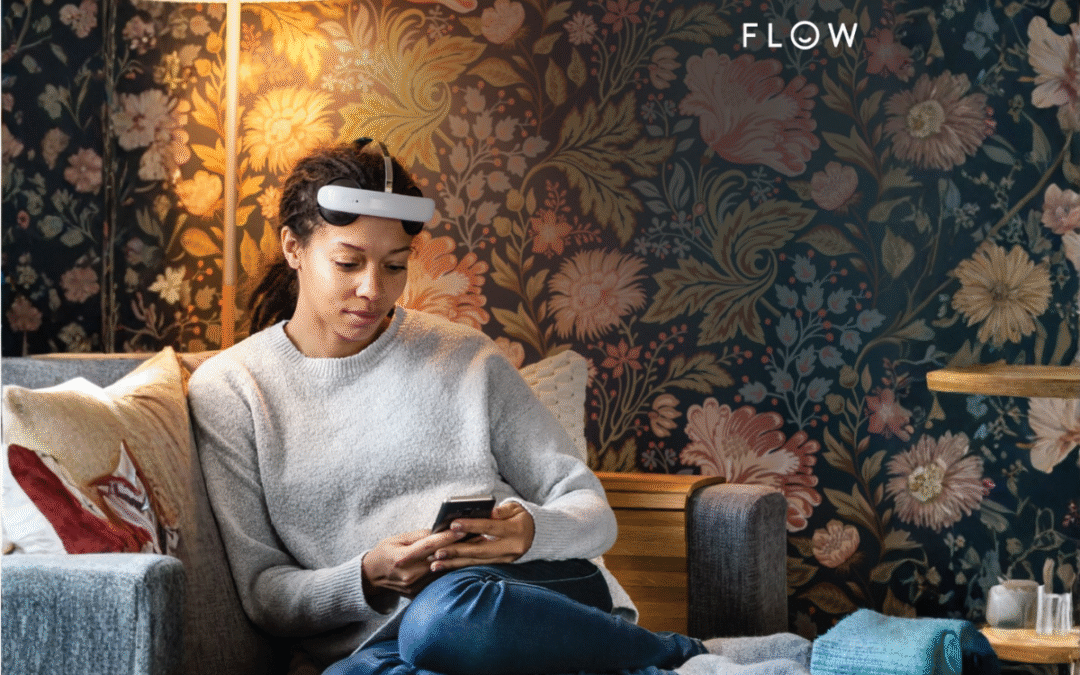Depression remains one of the most common and challenging conditions managed in mental-health care. Despite a wide range of pharmacological and psychotherapeutic options, many patients continue to experience residual symptoms and side effects.
We are now a distributor of Flow Neuroscience, a medical device that combines transcranial direct current stimulation (tDCS) with a digital behavioural-therapy app programme.
In Australia the Flow Headset FL-100 is intended for the treatment of adults 18+ with major depressive disorder (MDD), also called unipolar depression, either as monotherapy or as an adjunctive treatment. The device is able to be used at home under the supervision of an appropriately qualified health practitioner.
In this post, we outline the clinical evidence, mechanism of action, and practical considerations for incorporating Flow into your practice.
What Is Flow?
Flow is a non-invasive, home-based tDCS headset that applies a gentle 2mA current to the left dorsolateral prefrontal cortex (DLPFC). A region consistently shown to be hypoactive in those who experience depression (Koenigs & Grafman, 2009). Through enhancing neuronal activity in this area, Flow supports improved mood regulation without the systemic side-effects commonly associated with antidepressant medication (Flow Neuroscience, 2025).
Paired with a smartphone app delivering over 50 short behavioural-therapy sessions. Covering behavioural activation, exercise, diet, sleep hygiene and more.
Efficacy
Flow has been validated in a multisite, double-blind, placebo-controlled randomised superiority trial:
- 5 % remission rate on the MADRS scale at 10 weeks effective as both monotherapy and adjunct to antidepressants (Woodham et al, 2024).
Open-label patient cohort study in an NHS primary care general practice found at 6 weeks:
- 1% of patients showed reliable improvement, and 32.3% achieved remission using the PHQ-9
- Significant improvements were observed in functioning (WSAS) and health-related quality of life (EQ-5D-5L)
Real-world data from more than 20,000 users shows a low adverse reactions rate of 4.5 % (Griffiths et al, 2024).
Treatment Protocol
The recommended initial course is 10 weeks, structured as:
| Phase | Duration | Sessions per week | Session Length | What else happens |
| Activation | Weeks 1-3 | 5 Stimulations | 30min | Introduces optional behavioural therapy courses via the app |
| Strengthening | Weeks 4+ | Up to 2 stimulations a week | 30min | Continues to strengthen and preserve results and continue behavioural therapy courses |
Patients complete a weekly MADRS-S survey to track progress. The supervising health practitioner can individualise the schedule (up to 1 session per day, 7 per week) using the secure Flow Clinician Platform, which provides adherence data and enables remote protocol adjustments (Flow Neuroscience, 2025) based on the authorised clinician level approved.
Safety and Contraindications
Flow has no absolute contraindications, however warnings and precautions include:
- Broken/inflamed/infected skin (including, for example, psoriasis) at the electrode site
- Cranial or intracranial implant (e.g. brain clips, deep brain stimulators)
- Craniofacial abnormalities (e.g., congenital deformities, severe trauma, or reconstructive surgeries) which may affect electrode placement
- Epilepsy or history of seizures
- Active suicidal ideation (requires closer monitoring)
- History of hypomania or mania (may require closer monitoring)
For additional information around warnings and precautions please refer to the Flow Neuroscience FL-100 User Manual.
Special populations
Other chronic conditions: No known interactions with medications; used by individuals with diabetes, heart disease, hypertension, asthma, co- occurring mental health conditions, neurodivergence, and brain injuries/ disorders without reported safety concerns.
Pregnancy: Not licensed for use; no safety concerns identified in existing studies, research ongoing.
Breastfeeding: Safe to use; no effect on breast milk production.
Postpartum: Appears safe for postpartum depression and successfully used in NHS pilots.
Children and Adolescents: Not licensed for use; studies ongoing for ages 14+
Why Integrate Flow Into Your Practice
- Adjunct or stand-alone: Use alongside pharmacotherapy or psychotherapy to improve remission rates.
- Remote monitoring: The Clinician Platform supports telehealth workflows and data-driven treatment reviews.
- Low side-effect burden: Offers an option for patients’ intolerant to, or disengaged from, antidepressants (Wang et al, 2021).
- Evidence-backed: Randomised controlled data and extensive real-world use underpin clinical confidence.
Contact us to discuss how to offer Flow tDCS therapy into your practice. Visit our Flow information page or email us on info@aurorabioscience.com.au to arrange a demonstration or clinician training session.
ARTG No. 509725 and 510555
Aurora BioScience Pty Ltd is the Australian TGA sponsor for Flow Neuroscience. Flow – Transcranial Direct Current stimulator (tDCS) is only to be used under the supervision of an appropriately qualified health practitioner
Reference list
Wang, J., Luo, H., Schülke, R., Geng, X., Sahakian, B. J., & Wang, S. (2021). Is transcranial direct current stimulation, alone or in combination with antidepressant medications or psychotherapies, effective in treating major depressive disorder? A systematic review and meta-analysis. BMC Medicine, 19, Article 319. https://doi.org/10.1186/s12916-021-02181-4
Woodham, R. D., Selvaraj, S., Lajmi, N., et al. (2024). Transcranial direct current stimulation for depression: A multicentre randomised controlled trial. Nature Medicine. https://doi.org/10.1038/s41591-024-03007-x
Griffiths, C., Smart, D., Zafar, A., & Jiang, H. (2024). Flow transcranial direct current stimulation (tDCS) for depression treatment in a primary healthcare general practice: An open-label cohort study. Open Journal of Depression, 13(2), 25–39. https://doi.org/10.4236/ojd.2024.132003
Flow Neuroscience. (2025.). Flow treatment overview. Retrieved October 2025, from https://hcp.flowneuroscience.com/flow-treatment/

